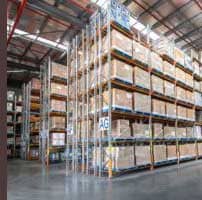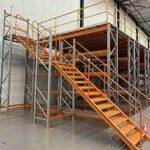In the dynamic world of business operations, growth is a double-edged sword. While expansion signifies success, it also introduces the challenge of finding additional space to accommodate that growth. Many businesses immediately consider extending their physical footprint or relocating to larger premises, not realizing the environmental impact and the higher costs associated with these options. However, an innovative solution lies within the existing premises, specifically utilising the often-overlooked overhead space. Here’s how you can expand your usable floor space, minimise your carbon footprint, and save costs simultaneously.
Table of contents
- Install a Mezzanine Floor: Increase Warehouse space
- Leverage Multi-Tiered Shelving Systems
- The Benefits of Vertical Space Utilisation
- Conclusion
- Next Steps
- Frequently asked questions
- How can I maximise warehouse space utiliSation??
- What are some ways to improve warehouse space management?
- How can I optimise my warehouse for better storage capacity?
- What should I do if my warehouse is running out of space?
- How can warehouse operations benefit from automated storage and retrieval systems?
- What role does warehouse management software play in optimising warehouse space?
Install a Mezzanine Floor: Increase Warehouse space
Consider the vertical approach! Adding a mezzanine floor in your warehouse can increase floor space without changing the warehouse’s footprint. This additional floor level can be built within the existing structure, allowing you to double or triple the usable area without expanding the warehouse’s boundaries. A mezzanine floor enables you to maximise vertical space and use the available area efficiently.
Increase storage capacity by utilising the overhead space for less frequently accessed items or creating a separate workspace on the mezzanine level. Implementing a mezzanine floor can help organise your warehouse better as you can designate specific areas for different categories of items, making inventory management more efficient.
Furthermore, mezzanine floors can be customised to suit your specific requirements, ensuring that the additional space seamlessly complements your existing warehouse layout. This solution offers a cost-effective and practical way to expand your storage capabilities vertically, optimising warehouse operations.
With the option for multi-tiered designs, the potential for space maximisation is enormous. Access is easy with staircases, and lifts, pallet gates, chutes, and conveyors can be incorporated for logistical efficiency.
Leverage Multi-Tiered Shelving Systems
Another effective method to maximise warehouse space is by leveraging multi-tiered shelving systems. This is a brilliant solution for warehouses experiencing an increase in inventory but facing space constraints because these systems utilise the vertical space efficiently by providing multiple levels of shelving for storing inventory. By using the height of the warehouse effectively, you can significantly increase the storage capacity within the same floor space.
Multi-tiered shelving systems offer flexibility in organising inventory based on size, type, or frequency of access. By categorising items and assigning them to different levels of shelving, you can streamline warehouse operations and enhance inventory management. This system allows for easy accessibility to goods while optimising the available warehouse space.
Moreover, multi-tiered shelving systems can be customised to fit the dimensions of your warehouse, maximising the storage area without compromising accessibility. By utilising the vertical space efficiently, you can improve the overall efficiency of your warehouse operations.
Implement a Tall Racking Configuration
Making full use of all the available space in your warehouse involves making use of the space above by implementing a tall racking system, such as Very Narrow Aisle (VNA) configuration. This allows you to make the most out of the vertical storage capacity. These systems can be customised to reach the maximum height of your warehouse, with the benefit of narrow aisles to accommodate more racks. Specialised forklifts are used to access items stored at height, ensuring that operational efficiency is not compromised while maximising space utilisation.
Maximise storage efficiency with the use of a tall racking setup that can accommodate items of different sizes and weights effectively. Utilising the vertical space in the warehouse helps reduce wasted storage area and optimise utilisation of available space. Furthermore, tall racks ensure convenient access to inventory, thereby improving warehouse operations and inventory management.
Improve the efficiency of storage and retrieval procedures by incorporating a tall racking system that meets the needs of your warehouse operations. By effectively utilising vertical space, you can enhance warehouse capacity and streamline storage processes in your facility.
Additional Strategies to Maximise Warehouse Storage Space
- Optimise Layout and Workflow: Regularly review and optimise your warehouse layout to ensure efficient use of space and workflow. Consider the placement of racks, workstations, and equipment to minimise wasted space and improve productivity.
- Implement Inventory Management Techniques: Adopting just-in-time (JIT) inventory or similar strategies can reduce the amount of stock held on-site, freeing up space for other uses.
- Use Vertical Carousel Systems: For smaller items, vertical carousel systems can offer high-density storage that maximises vertical space while providing easy and quick access to materials.
The Benefits of Vertical Space Utilisation
Maximising warehouse storage space by leveraging vertical dimensions addresses the immediate need for additional storage and operational areas and promotes sustainability by reducing the need for physical expansion. These strategies offer a cost-effective alternative to relocation or construction, with the advantage of minimising environmental impact.
- More Organised:
Utilising vertical space in a warehouse offers numerous benefits that go beyond increasing storage capacity. By optimising the vertical space, you can create a more organized and efficient warehouse layout. This allows for better inventory categorisation and easier access to stored items, improving overall warehouse operations. - Cost Effective:
Effectively utilising the height of the warehouse can also lead to cost savings by minimising the need for additional warehouse space. By maximising the available vertical space, you can avoid the unnecessary costs associated with expanding the warehouse horizontally, making better use of the existing facility. - Inventory Management:
Moreover, vertical space utilisation enables better inventory visibility and tracking, enhancing inventory management practices. By storing items vertically, you can maintain a clear overview of stock levels and locations, facilitating accurate stock replenishment and reducing the risk of stockouts.
Conclusion
The challenge of needing more warehouse space as your business grows can be met with innovative and efficient vertical space utilisation strategies. By installing mezzanine floors, leveraging multi-tiered shelving systems, and implementing tall racking configurations, businesses can maximise warehouse space effectively within their existing footprint. These solutions and additional strategies, like optimising warehouse layout and adopting advanced inventory management techniques, can transform your space constraints into opportunities for growth and efficiency.
By adopting these vertical expansion strategies, businesses can ensure they make the most efficient use of their warehouse space, fostering growth without the need for costly and environmentally impactful expansion.
Next Steps
- Book a Free Inspection: Contact Total Racking Systems to book a Free onsite warehouse consultation in Sydney or Newcastle
- Learn More: Read our article about How to choose the best size, height and load rating for your rpallet racking or our getting more space with narrow aisle racking
- Get a Quote: Buy pallet racking to increase vertical storage
- Reach Out: For more information or assistance, contact Total Racking Systems.
Frequently asked questions
How can I maximise warehouse space utiliSation??
You can maximise warehouse space utilisation by implementing optimised storage solutions such as pallet storage systems, automated storage and retrieval systems, and efficient warehouse management systems.
What are some ways to improve warehouse space management?
You can improve warehouse space management by utilising storage racks, optimising storage locations, implementing inventory management systems, and introducing automated storage solutions.
How can I optimise my warehouse for better storage capacity?
To optimise your warehouse for better storage capacity, you can consider maximising space utilisation, implementing space optimisation techniques, and investing in storage systems that increase storage density.
What should I do if my warehouse is running out of space?
If your warehouse is running out of space, you can explore ways to maximise warehouse space utilisation, consider automated storage solutions, and review your inventory management processes to free up space.
How can warehouse operations benefit from automated storage and retrieval systems?
Warehouse operations can benefit from automated storage and retrieval systems by improving efficiency, maximising space utilisation, reducing errors, and increasing storage capacity.
What role does warehouse management software play in optimising warehouse space?
Warehouse management software plays a crucial role in optimising warehouse space by providing real-time insights, facilitating inventory management, streamlining workflows, and enhancing space utilisation strategies.





